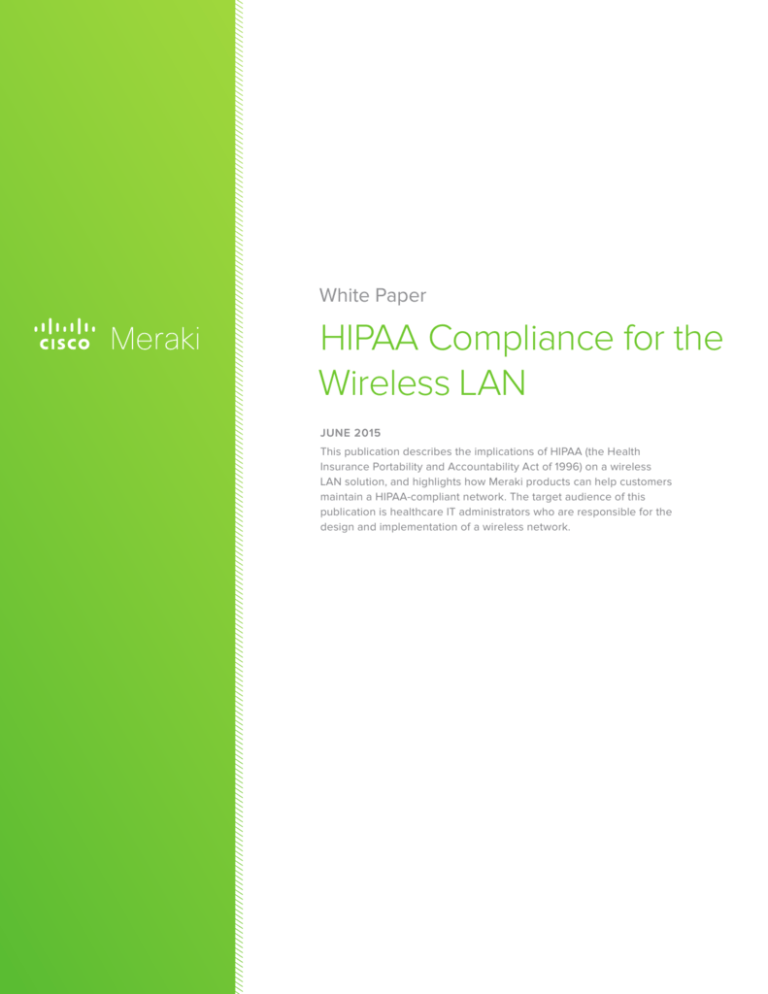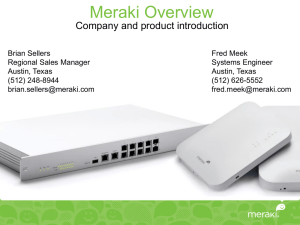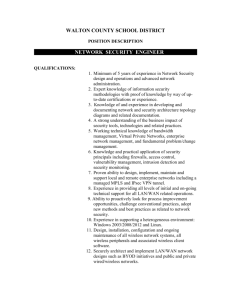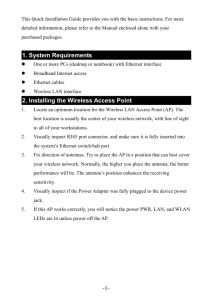
White Paper
HIPAA Compliance for the
Wireless LAN
JUNE 2015
This publication describes the implications of HIPAA (the Health
Insurance Portability and Accountability Act of 1996) on a wireless
LAN solution, and highlights how Meraki products can help customers
maintain a HIPAA-compliant network. The target audience of this
publication is healthcare IT administrators who are responsible for the
design and implementation of a wireless network.
Table of Contents
1 Overview3
2 Background
4
3 Technical Safeguards6 3.1 Unique User Identification
6
3.2 Emergency Access
6
3.3 Automatic Logoff
6
3.4 Authentication, Integrity, and Encryption
6
3.5 Audit Controls
7
4 Adminstrative Safeguards
8
4.1 Log-In Monitoring
8
4.2 Password Management
8
4.3 Response and Reporting 8
4.4 Data Backup and Recovery 8
4.5 Emergency Mode Operation
9
5 Physical Safeguards10
5.1 Facility Security Plan
10
5.2 Media Re-use
10
6 Providing a HIPAA-Compliant Wireless LAN with Meraki 11
2
6.1 Technical Safeguards
11
6.2 Adminstrative Safeguards
12
6.3 Physical Safeguards
12
Cisco Systems, Inc. | 500 Terry A Francois Blvd, San Francisco, CA 94158 | (415) 432-1000 | sales@meraki.com | © 2015 Cisco and/or its affiliates. All rights reserved.
1 Overview
HIPAA (the Health Insurance Portability and Accountability Act of 1996) calls for the establishment
of national standards for technology involved in health care transactions in order to protect the
health information of individuals. HIPAA applies to any healthcare facility that exchanges patient
health information. HIPAA’s objective is to ensure that health information remains private and
secure.
Achieving this objective involves not only implementing policies and procedures for personnel,
workflows, and inventory, but also evaluating physical assets to ensure that every piece of
equipment will play its part in enabling HIPAA compliance. A wireless LAN is no exception. Wireless
hardware, such as access points (APs) that are installed around a facility, must facilitate HIPAA
compliance. Similarly, wireless software must support the security and management features that
the facility requires to enforce HIPAA compliance.
This whitepaper summarizes the key tenets of HIPAA that are relevant to a wireless LAN, describes
the wireless features that can assist in satisfying these requirements, and shows how Meraki
products can be used to help build a HIPAA-compliant wireless network.
3
Cisco Systems, Inc. | 500 Terry A Francois Blvd, San Francisco, CA 94158 | (415) 432-1000 | sales@meraki.com | © 2015 Cisco and/or its affiliates. All rights reserved.
2 Background
Enacted by the U.S. Congress in 1996, HIPAA comes in two parts: Title I and Title II. Title II
of HIPAA strives to reduce health care fraud and abuse. Subtitle F of Title II is known as the
“Administrative Simplification” provision, which requires the establishment of national standards
for electronic health care transactions, along with national identifiers for various health care
entities (e.g., providers, health insurance plans, etc.). Administrative Simplification defines 5
“rules”, one of which is the Security Rule, which describe the requirements related specifically to
electronically protected health information.
The Security Rule identifies 3 types of security safeguards required for compliance:
1.
Administrative safeguards define personnel and management processes to train employees who come into contact with private health information, as well as procedures for
detecting and handling privacy violations.
2. Physical safeguards are policies and procedures that govern the addition and removal of
hardware, access to equipment, etc.
3. Technical safeguards are guidelines for data encryption, data corroboration, and audit
logging.
However, HIPAA does not provide specific, technical guidance. HIPAA defines the policy that
must be implemented; the actual implementation (i.e., “codification”) of this policy is left to
the Code of Federal Regulations (CFR). CFR Title 45, Part 164 is called “Security and Privacy”.
Subpart C of this section, “Security Standards for the Protection of Electronic Protected Health
Information”, translates HIPAA’s 3 security safeguards (administrative, physical, and technical) into
actionable requirements that a wireless LAN must satisfy. Specifically, the regulation supplements
each HIPAA safeguard with a list of “standards”, and each standard may consist of one or more
“implementation specifications”, which are designated as either “required” or “addressable” (i.e.,
to be implemented if applicable).
The implementation specifications relevant to a wireless LAN are listed below and described
greater detail in the following sections. (Each section begins by listing the implementation
specifications addressed in parentheses.) The technical safeguards define the greatest number
of implementation specifications that impact the wireless LAN, so that section is addressed first.
Many of the other implementation specifications are outside the scope of a wireless LAN because
they either pertain to overarching security policies and processes (e.g., workforce clearance
procedure) that are not technology-specific, or they pertain to a different technology area that is
not related to wireless connectivity (e.g., protection from malicious software).
4
Cisco Systems, Inc. | 500 Terry A Francois Blvd, San Francisco, CA 94158 | (415) 432-1000 | sales@meraki.com | © 2015 Cisco and/or its affiliates. All rights reserved.
5
Cisco Systems, Inc. | 500 Terry A Francois Blvd, San Francisco, CA 94158 | (415) 432-1000 | sales@meraki.com | © 2015 Cisco and/or its affiliates. All rights reserved.
3 Technical Safeguards
All but one of the implementation specifications for the technical safeguards should be addressed
by a wireless LAN. However, because of the importance of this section, all the implementation
specifications will be addressed.
6
3.1 Unique User Identification
(Access Control: Unique User Identification)
This specification requires a system that passes private health information to control access on a per-user basis. Within a wireless LAN, each user must be assigned a unique username and strong password and must use these credentials to access the wireless network. The wireless LAN should also be able to track these users in a log of user activity (e.g., successful and failed authentication attempts, association and disassociation times, etc.). Finally, the wireless LAN should be able to provide different levels of access to different groups of users. For instance, guests should obtain Internet-only connectivity from the wireless network, without any ability to reach private health information. Employees, on the other hand, might be granted broader access to the network. A wireless LAN can provide this access control by broadcasting different SSIDs (the wireless networks that a client device detects), allowing an administrator to configure different access control settings on each SSID.
3.2
Emergency Access
(Access Control: Emergency Access Procedure)
An emergency access procedure allows personnel to access private health information during an emergency. A wireless LAN may assist with this requirement by providing LAN access to wireless users, even if connectivity to the public Internet is down. In this way, personnel can wirelessly access health information that may be stored on local file shares during an emergency. This “always up” capability is revisited as part of the emergency mode operation plan, which is specified as part of the administrative safeguards.
3.3
Automatic Logoff
(Access Control: Automatic Logoff)
Automatic logoff terminates a user’s session after a predetermined time of inactivity. This feature is most relevant to the application that provides the user with access to private health information. A wireless LAN may perform its own automatic logoff to disconnect a user after a preconfigured period of time.
3.4
Authentication, Integrity, and Encryption
(Access Control: Encryption and Decryption, Integrity: Mechanism to Authenticate Electronic Protected Health Information, Person or Entity Authentication, Transmission Security: Integrity Controls, Transmission Security: Encryption)
The objective of all the implementation specifications is to provide authentication to ensure that information is accessed by a trusted or approved user, integrity to ensure
Cisco Systems, Inc. | 500 Terry A Francois Blvd, San Francisco, CA 94158 | (415) 432-1000 | sales@meraki.com | © 2015 Cisco and/or its affiliates. All rights reserved.
7
that information is not altered in transit, and confidentiality to prevent a “man in the middle” from stealing information as it is transmitted. All 3 attributes are intrinsically connected; as such, they should be satisfied simultaneously and comprehensively, rather than piecemeal.
Best practices for user authentication include 802.1X (also known as WPA2-Enterprise), which uses public key infrastructure (PKI) to authenticate endpoints, provide integrity through digitally signed data packets, and negotiate cipher keys for the strongest encryption possible (i.e., 256-bit AES). Older authentication and encryption methods have some downsides. WPA2 with a pre-shared key (WPA2-PSK, also called WPA2-Personal) provides sufficient encryption with a suitably long and complex key, but pre-shared keys can easily be shared with other (potentially unauthorized) users. A less problematic variation is to use WPA2-PSK with a splash page that requires a user to enter username/password credentials. It is highly recommended that WEP not be used in an organization concerned about HIPAA. Not only does WEP suffer from the same ease of key sharing among users as WPA2-PSK, but with today’s processor speeds, it is also far too easy to crack a WEP key. The bottom line: Use (1) 802.1x or (2) WPA2-PSK with username/password splash page login.
3.5
Audit Controls
(Audit Controls)
Audit controls enable an administrator to monitor user activity on systems that access private health information. A wireless LAN should provide a log of user-level events, such as associations, authentications, and bandwidth usage. The log should be descriptive enough to allow an administrator to pursue the appropriate remediation steps (e.g., block the device, contact the user, etc.).
Cisco Systems, Inc. | 500 Terry A Francois Blvd, San Francisco, CA 94158 | (415) 432-1000 | sales@meraki.com | © 2015 Cisco and/or its affiliates. All rights reserved.
4 Adminstrative Safeguards
The administrative safeguards are mostly concerned with the management procedures and
processes that govern how private health information is handled. A few of the implementation
specifications defined as part of administrative safeguards have implications for the wireless LAN.
4.1 Log-in Monitoring
(Security Awareness and Training: Log-in Monitoring)
Log-in monitoring calls for record-keeping of the administrators who access any systems
that transmit or store private health information. For a wireless LAN, these records are
important for forensic analysis. For instance, an administrator might inadvertently disable
encryption on the wireless network, which could allow an eavesdropper to capture private
health information over the air. A record of administrator logins (both successful and
unsuccessful) and their configuration changes allows an organization to determine who
made the configuration change to disable wireless encryption and when the change took
place, which identifies the exposure time of the misconfiguration.
4.2
Password Management
(Security Awareness and Training: Password Management)
Password management requires procedures for creating, changing, and safeguarding
administrative passwords. Every wireless LAN should be able to provide this capability
in a scalable and centralized way. Rather than replicating administrative accounts on
individual APs (as is the case with “autonomous” or “fat” APs), a centralized management
solution should be sought, which manages and stores administrative accounts to access
all APs across the entire network.
4.3
Response and Reporting
(Security Incident Procedures: Response and Reporting)
A mechanism is needed to alert administrators to suspected or known security incidents,
to mitigate the incidents as much as possible and to document the incidents and their
outcomes for future analysis. A wireless LAN should provide as much information to
administrators as possible through these alerts. Security alerts should report on security
incidents that pertain to administrators, (e.g., excessive administrative login attempts),
wireless users (e.g., excessive user login attempts), and wireless devices (e.g., rogue
AP detection). Management alerts should report on any events that are actionable by
administrators—for instance, if an AP goes down.
3.4
Authentication, Integrity, and Encryption
(Contingency Plan: Data Backup Plan, Contingency Plan: Disaster Recovery Plan)
These implementation specifications call for procedures to back up data and recover data
after the emergency is over. For a wireless LAN, the most critical data typically resides in
the management interface and may consist of configuration, administrative accounts, and
user accounts. (Larger organizations would likely store and manage user accounts on a
dedicated authentication server, such as Active Directory. This server would have to be
backed up separately.) A controller-based wireless LAN typically provides an administrator
8
Cisco Systems, Inc. | 500 Terry A Francois Blvd, San Francisco, CA 94158 | (415) 432-1000 | sales@meraki.com | © 2015 Cisco and/or its affiliates. All rights reserved.
with the ability to export a configuration file off of the controller. This configuration file can
be uploaded back to the controller in order to restore settings. Alternatively, a cloudmanaged wireless LAN should provide this data backup to an organization transparently
through redundant systems in multiple geographically distributed data centers.
4.5
Emergency Mode Operation
(Contingency Plan: Emergency Mode Operation Plan)
Systems should be able to tolerate failures and outages gracefully during emergencies.
Systems should remain operational as much as possible so that private health information
can still be accessed. The need for a wireless LAN to continue operating when the
public Internet is unavailable was discussed as part of technical safeguards. Here, the
architectural and administrative implications of providing an “always up” wireless LAN
are considered. At a high level, a wireless LAN should eliminate single points of failure.
A common limitation of controller-based wireless LANs is that the controller must be
reachable by the APs in order for the wireless network to remain operational. As such,
administrators often find themselves deploying redundant standby controllers that take
over when the primary controllers go down—a deployment with significant cost and
management implications. More preferable is an architecture that eliminates the controller
as a single point of failure. In general, a cloud-managed wireless LAN allows the APs to
remain operational (i.e., providing wireless access to users), even when connectivity to the
cloud-based management interface is unavailable.
9
Cisco Systems, Inc. | 500 Terry A Francois Blvd, San Francisco, CA 94158 | (415) 432-1000 | sales@meraki.com | © 2015 Cisco and/or its affiliates. All rights reserved.
5 Physical Safeguards
The implementation specifications for physical safeguards are generally outside the scope of the
wireless LAN. They relate mostly to controlling access to facilities and equipment—in particular,
those that store private health information. However, the implementation specifications below
should be addressed by a wireless LAN.
5.1 Facility Security Plan
(Facility Access Controls: Facility Security Plan)
The facility security plan describes the need to secure physical property and equipment
from unauthorized physical access, tampering, and theft. In a wireless LAN, the APs are
the components that are generally most prone to tampering. APs should be secured
by locks (e.g., Kensington locks and mounting brackets) and positioned out of reach of
users. Example mounting locations include high on walls, on ceilings, or inside the plenum
(if the APs are plenum-rated). For a controller-based wireless LAN, the controller is the
most expensive piece of hardware in the network. As such, it also needs to be secured,
typically inside an access-restricted data center. Besides being a target for theft and
tampering, the controller is also a target for network security breaches. Many security
vulnerabilities have been identified with wireless LAN controllers over the years. Gaining
access to a controller can compromise not just the wireless LAN, but even the entire
network. Organizations that want to minimize their security exposure should consider a
cloud-managed wireless LAN, which eliminates the need for a controller altogether.
5.2
Media Re-use
(Device and Media Controls: Media Re-use)
If a system stores private health information, there needs to be a way to clear that
information before the system is reused for a different purpose. For a wireless LAN, the
implication is simple: ideally, no component of the wireless LAN should ever store user
data.
10
Cisco Systems, Inc. | 500 Terry A Francois Blvd, San Francisco, CA 94158 | (415) 432-1000 | sales@meraki.com | © 2015 Cisco and/or its affiliates. All rights reserved.
6 Using Meraki in Your HIPAA-Compliant
Wireless LAN
Meraki’s cloud-managed APs enable an organization maintain a wireless LAN that can satisfy
HIPAA’s implementation specifications. The requirements described earlier are revisited below to
show how Meraki can be used in your network.
6.1 Technical Safeguards
REQUIREMENT
HOW MERAKI FITS IN
Unique User Identification
Meraki APs can broadcast up to 15 SSIDs simultaneously,
each with its own security, network, and access control settings. In addition, individual network group policies, VLAN
assignment, and MDM integration provide granular security
control. For authentication, Meraki supports 802.1x and
username/password login via a splash page. User credentials can be validated against either a customer-premise
authentication server (such as Active Directory, LDAP, or
RADIUS) or a Meraki-hosted authentication server. Through
the Meraki Cloud, an administrator can obtain a log of the
users and devices that have connected to the Meraki wireless network, and view a history of network usage.
Emergency Access
The Meraki wireless LAN stays up, even if connectivity to
the Meraki Cloud becomes unavailable. Users can continue
accessing LAN resources without interruption.
Authentication, Integrity,
and Encryption
Meraki supports WPA/WPA2-Enterprise (802.1x) with strong
256-bit AES encryption and WPA/WPA2-Personal (preshared key). Communication between the APs and the
Meraki Cloud is conducted over a secure SSL connection.
Audit Controls
A customer network administrator can see events related to
wireless users on the Meraki network, including wireless associations/disassociations, authentication attempts, DHCP
requests/renewals, and traffic initiation.
11
Cisco Systems, Inc. | 500 Terry A Francois Blvd, San Francisco, CA 94158 | (415) 432-1000 | sales@meraki.com | © 2015 Cisco and/or its affiliates. All rights reserved.
6.2 Administrative Safeguards
REQUIREMENT
HOW MERAKI FITS IN
Log-in Monitoring
The Meraki Cloud provides a log of administrative activity,
including logins and configuration changes. In addition,
different privilege levels (read-only and full read-write
access) can be specified for different administrators.
Granular administrative privileges can be flexibly applied by
network tag.
Password Management
A customer network administrator can create, modify, and
delete other administrator accounts through the Meraki
Cloud. A single account can be used to configure and monitor thousands of Meraki APs in a single network. The Meraki
Cloud can also be configured to enforce password complexity requirements, account lockout thresholds, password
expiry, and two-factor authentication.
Response and Reporting
A whole suite of security and management alerts can be
communicated to administrators, including rogue AP detection and AP outages. Live tools enable an administrator to
troubleshoot an AP in a remote office without requiring any
on-site resources.
Data Backup and
Recovery
The Meraki Cloud is hosted in multiple geographically distributed data centers for high availability and reliability.
Emergency Mode
Operation
A wireless LAN built using Meraki APs does not require any
hardware-based wireless LAN controllers, reducing physical and network security risk.
6.3 Physical Safeguards
REQUIREMENT
HOW MERAKI FITS IN
Facility Security Plan
Each Meraki AP comes with a security screw, Kensington
lock hard point, and a padlock hard point. Models are
available with Plenum rating.
Media Re-use
No user traffic is ever stored on a Meraki AP, nor does user
traffic flow back to the Meraki Cloud.
For more information on how Meraki can help you build a HIPAA-compliant wireless network with Meraki APs,
please contact an authorized Meraki partner. Or, you can contact Meraki directly at 1.888.490.0918 or www.meraki.cisco.com.
12
Cisco Systems, Inc. | 500 Terry A Francois Blvd, San Francisco, CA 94158 | (415) 432-1000 | sales@meraki.com | © 2015 Cisco and/or its affiliates. All rights reserved.








